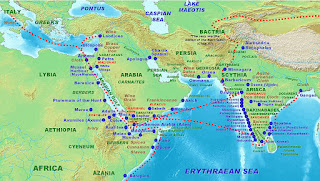In the annals of history, the journey of St. Thomas, one of the twelve apostles of Jesus Christ, holds a unique allure. Tradition holds that St. Thomas ventured to India, traversing the vast expanse of the Indian Ocean to spread the message of Christianity. His arrival in India, set against the backdrop of ancient maritime trade and military expeditions, intertwines faith with the realities of a bustling maritime world.
Setting Sail: Maritime Indo-Roman Trade in Antiquity
During the 1st century AD, the Indian Ocean served as a bustling thoroughfare of trade and cultural exchange. From the bustling ports of the Roman Empire to the kingdoms of the Indian subcontinent, maritime trade routes crisscrossed the vast expanse of the ocean, connecting distant lands in a web of commerce and diplomacy.
Roman historian Pliny the Elder once remarked, "India, China, and the Arabian Peninsula...are pouring their treasures into the lap of the world." Indeed, the riches of the East, including spices, silk, pearls and precious stones, flowed westward along maritime routes that spanned from the Red Sea to the Malabar Coast of India.
War and Commerce on the High Seas
The maritime domain was not merely a realm of peaceful trade but also a theater of conflict and conquest. Ancient empires and kingdoms vied for control of lucrative trade routes, employing formidable naval fleets to safeguard their interests and expand their influence.
The Roman Empire, with its mighty navy, patrolled the Mediterranean Sea and ventured into the Indian Ocean in search of wealth and power. Roman historian Tacitus chronicled the exploits of Roman fleets in distant waters, highlighting their encounters with the kingdoms of India and the riches they brought back to Rome.
In the East, Indian kingdoms such as the Chera, Chola, and Pandya dynasties boasted formidable maritime capabilities of their own. They deployed fleets of sturdy ships, equipped with sails and oars, to safeguard trade routes and engage in commerce with distant lands.
St. Thomas: A Voyage of Faith
Amidst the ebb and flow of maritime trade and military expeditions, the figure of St. Thomas emerges as a beacon of faith navigating the tumultuous seas of antiquity. Tradition holds that St. Thomas, guided by his unwavering belief in the teachings of Jesus Christ, embarked on a journey that would take him to the shores of India.
As he traversed the vast expanse of the Indian Ocean, St. Thomas bore witness to the bustling ports and bustling markets that dotted the coastline. He encountered diverse cultures and peoples, sharing the message of Christianity with those he met along the way.
Conclusion: Faith on the High Seas
In retracing the journey of St. Thomas through the maritime world of ancient India, we glimpse the profound intersection of faith and history. Against the backdrop of bustling ports and naval conquests, St. Thomas embarked on a voyage of spiritual enlightenment, leaving an indelible mark on the shores of India and the annals of Christianity. As we navigate the seas of faith in our own lives, may we draw inspiration from the courage and conviction of those who sailed before us, guided by their unwavering belief in the power of divine providence.





No comments:
Post a Comment